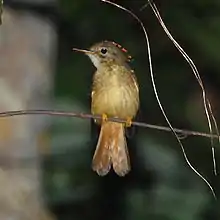Royal flycatcher
The royal flycatchers are a genus, Onychorhynchus, of passerine birds in the family Tityridae.[1]
| Royal flycatcher | |
|---|---|
 | |
| Amazonian royal flycatcher at Apiacás, Mato Grosso state, Brasil | |
| Scientific classification | |
| Domain: | Eukaryota |
| Kingdom: | Animalia |
| Phylum: | Chordata |
| Clade: | Dinosauria |
| Class: | Aves |
| Order: | Passeriformes |
| Family: | Tityridae |
| Subfamily: | Oxyruncinae |
| Genus: | Onychorhynchus Fischer von Waldheim, 1810 |
Names
The specific epithet of the type species, coronatus, and the common name of all the species in this genus, royal flycatcher, refer to the striking, colourful crest,[2] which is seen displayed very rarely,[2] except after mating, while preening, in courtship as well as being handled.[2]
The genus name Onychorhynchus comes from the Greek words ὄνυξ onyx "nail" and ρυγχος rhynkhos "bill".[3]
Species
The International Ornithological Committee (IOC) and BirdLife International's Handbook of the Birds of the World (HBW) places four species in the genus:[1][4]
| Image | Scientific name | Common Name | Distribution |
|---|---|---|---|
 | Onychorhynchus coronatus | Amazonian royal flycatcher | Amazon basin in northern Bolivia, eastern Peru, eastern Ecuador, eastern Colombia, Venezuela, the Guianas, and northern and western Brazil |
.jpg.webp) | Onychorhynchus mexicanus | Northern royal flycatcher | Mexico, south through most of Central America, to northwestern Colombia and far western Venezuela |
| Onychorhynchus occidentalis | Pacific royal flycatcher | Western Ecuador and far northwestern Peru | |
 | Onychorhynchus swainsoni | Atlantic royal flycatcher | Atlantic forest in southeastern Brazil |
The North American and South American Classification Committees of the American Ornithological Society (AOS) treat the genus as having one species, royal flycatcher (Onychorhynchus coronatus), with four subspecies. They place it in family Onychorhynchidae with four other species of two genera that the IOC and HBW include in Tityridae. The Clements taxonomy also treats the royal flycatcher as one species with four subspecies. It places that species, the same four additional species as the AOS, and the sharpbill (Oxyruncus cristatus) in family Oxyruncidae, which the AOS reserves for the sharpbill alone.[5][6][7]
References
- Gill, Frank; Donsker, David; Rasmussen, Pamela, eds. (2023). "Cotingas, manakins, tityras, becards". IOC World Bird List (v 13.0). International Ornithologists' Union. Retrieved 1 February 2023.
- Ridgely, Robert and John A. Gwynne Jr. (1989). A Guide to the Birds of Panama with Costa Rica, Nicaragua, and Honduras. Princeton University Press. ISBN 0691025126.
- Jobling, James A. (2010). Helm Dictionary of Scientific Bird Names. London, UK: Christopher Helm. p. 282. ISBN 978-1-4081-3326-2. OCLC 659731768.
- HBW and BirdLife International (2020) Handbook of the Birds of the World and BirdLife International digital checklist of the birds of the world Version 5. Available at: http://datazone.birdlife.org/userfiles/file/Species/Taxonomy/HBW-BirdLife_Checklist_v5_Dec20.zip [.xls zipped 1 MB] retrieved May 27, 2021
- "Check-list of North and Middle American Birds". American Ornithological Society. June 29, 2021. Retrieved August 9, 2021.
- Remsen, J. V., Jr., J. I. Areta, E. Bonaccorso, S. Claramunt, A. Jaramillo, D. F. Lane, J. F. Pacheco, M. B. Robbins, F. G. Stiles, and K. J. Zimmer. Version 24 August 2021. A classification of the bird species of South America. American Ornithological Society. https://www.museum.lsu.edu/~Remsen/SACCBaseline.htm retrieved August 24, 2021
- Clements, J. F., T. S. Schulenberg, M. J. Iliff, S. M. Billerman, T. A. Fredericks, J. A. Gerbracht, D. Lepage, B. L. Sullivan, and C. L. Wood. 2021. The eBird/Clements checklist of Birds of the World: v2021. Downloaded from https://www.birds.cornell.edu/clementschecklist/download/ Retrieved August 25, 2021